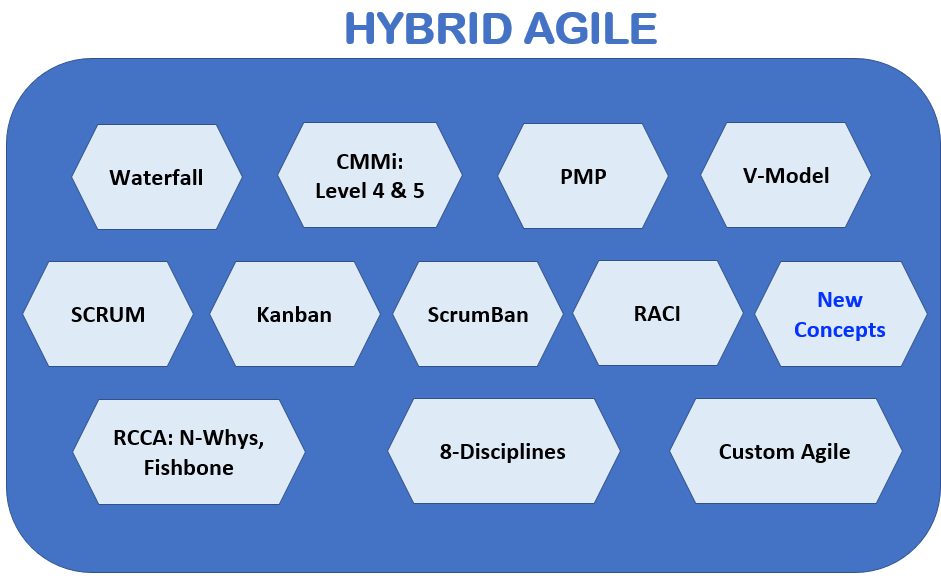by: VMware Information Security Strategy Program Manager Bhupendra Singh and VMware Security Strategy Director Craig Savage
Agile is a great way for teams to accelerate their projects. But like many frameworks, it can be rigid in its application and/or not take into account the variations different teams incorporate in their individual work processes. This can create a number of challenges within any given project, including lack of motivation, frustration, extended timelines, and similar.
At VMware, we took a new approach to projects, that we call Hybrid Agile, which melds the best of Agile techniques with the way teams work (and are most effective) in the real world. This approach transforms traditionally structured work methods into an organically evolved process, one that doesn’t begin as regimented steps that later result in a forced execution for compliance purposes. Hybrid Agile ensures that the well-being of all stakeholders and team members is always taken care of, enabling them to be more productive and satisfied than with traditional methods.
Hybrid Agile shouldn’t be a struggle
The best way to look at traditional Agile versus Hybrid Agile is to imagine a corporate wellness program that takes a ‘one size fits all’ approach (Agile). The overall goal is for everyone to get fit, but not every team member will be happy following a mandated exercise routine—such as swimming when they would prefer to jog. They ultimately become less productive and/or enthused as time goes on. This discontent can also potentially spread to members who are on board with the regimen, like those who love to swim. That endangers the entire program, as intended end-to-end scenarios are compromised or incomplete once the project is ‘finalized’.
Hybrid Agile takes into account each team member’s unique capabilities, interests, and ways of working/accomplishing milestones. It isn’t simply a different take on Agile rules and processes, but a true cultural change that brings out the best in teams—and stays constant even as projects and stakeholders change over time. It also involves an organically developed automated and intelligent workflow that serves as both guidance and practice as the team works.
Hybrid Agile even resolves non-Agile challenges teams face, such as:
- A lack of team member recognition, which can be a major demotivator.
- A lack of personal touch, which involves accountable teams deflecting ownership by blaming other teams, third parties or obsolete technology.
- A workplace disconnect in which leadership fails to define the big picture and other project components.
- An inability of managers to understand their own team members’ skills and competencies.
In the end, participants welcome the paradigm shift Hybrid Agile brings as they realize their work-life aligns with who they are as a person, possibly for the first time. Team members want to do their jobs to the best of their ability as the project process—like enjoyable exercise—remains fulfilling day in and day out.
What Hybrid Agile really is
Hybrid Agile encourages being situationally aware and encompasses features from numerous formal project management models. These include CMMi, 8D, waterfall, V-model, incremental and continuous small V-models, Agile Kanban, Agile Scrum, Agile Scrum-ban, PMP fast tracking and crashing, and continuous manual monitoring and refinement of the backlog—as well as other proven techniques. See Figure 1.

It is a holistic solution for a successful and satisfying way of working to achieve goals within the budget, not to mention a great way to address (and remedy) the challenges of existing Agile implementations.
Check out
Want to know more? Give us a call (and download the white paper)
Hybrid Agile is not only unique to each team member but unique to each company. That’s why we encourage you to contact your account team to schedule a briefing with us. No sales pitch, no marketing. Just straightforward peer conversations revolving around your company’s unique requirements.
In the meantime, please download the Hybrid Agile white paper. It offers an in-depth analysis of the abovementioned topics as well as serving as an excellent resource guide for anyone working with Agile.
VMware on VMware blogs are written by IT subject matter experts sharing stories about our digital transformation using VMware products and services in a global production environment. To learn more about how VMware IT uses VMware products and technology to solve critical challenges, visit our microsite, read our blogs and IT Performance Annual Report and follow us on SoundCloud, Twitter, and YouTube . All VMware trademarks and registered marks (including logos and icons) referenced in the document remain the property of VMware.



